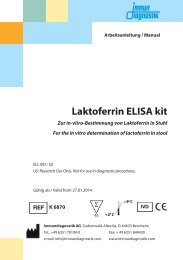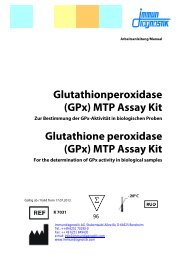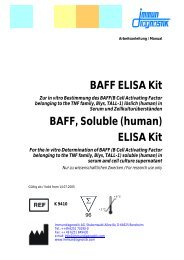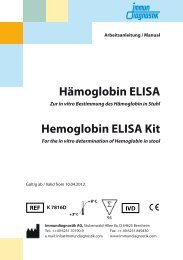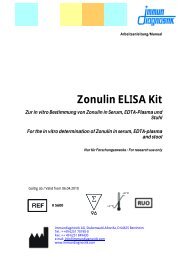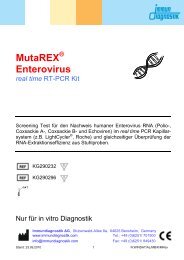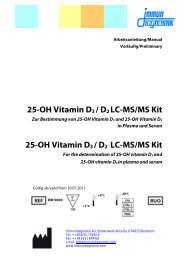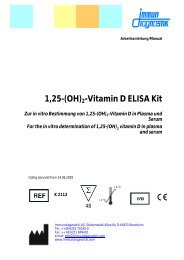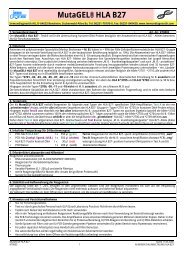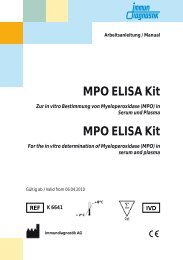Osteoprotegerin ELISA Kit - bei Immundiagnostik
Osteoprotegerin ELISA Kit - bei Immundiagnostik
Osteoprotegerin ELISA Kit - bei Immundiagnostik
Sie wollen auch ein ePaper? Erhöhen Sie die Reichweite Ihrer Titel.
YUMPU macht aus Druck-PDFs automatisch weboptimierte ePaper, die Google liebt.
Ar<strong>bei</strong>tsanleitung / Manual<br />
<strong>Osteoprotegerin</strong> <strong>ELISA</strong> <strong>Kit</strong><br />
Zur in vitro Bestimmung des OPG in Serum,<br />
EDTA-Plasma, Heparin-Plasma oder Citrat-Plasma<br />
For the in vitro determination of OPG in serum,<br />
EDTA plasma, Heparin plasma or Citrate plasma<br />
Gültig ab / Valid from 27.03.2012<br />
K 1011<br />
<strong>Immundiagnostik</strong> AG
Ar<strong>bei</strong>tsanleitung / Manual OPG<br />
Inhalt<br />
Content ______________________________________________________ 14<br />
1. VERWENDUNGSZWECK _______________________________________2<br />
2. EINLEITUNG _________________________________________________2<br />
3. TESTPRINZIP ________________________________________________2<br />
4. INHALT DER TESTPACKUNG ___________________________________3<br />
5. ERFORDERLICHE LABORGERÄTE UND HILFSMITTEL _______________4<br />
6. LAGERUNG DER REAGENZIEN UND PROBENVORBEREITUNG _______4<br />
7. HINWEISE UND VORSICHTSMASSNAHMEN ______________________5<br />
8. TESTDURCHFÜHRUNG ________________________________________5<br />
Hinweise____________________________________________________________ 5<br />
Pipettierschema_ _____________________________________________________ 6<br />
9. ERGEBNISSE ________________________________________________7<br />
10. TESTMERKMALE _____________________________________________7<br />
11. TESTCHARAKTERISTIKA ______________________________________8<br />
Präzision____________________________________________________________ 8<br />
12. TECHNISCHE MERKMALE _____________________________________9<br />
13. LITERATUR __________________________________________________9<br />
14. ALLGEMEINE HINWEISE ZUM TEST ___________________________ 10<br />
1
Ar<strong>bei</strong>tsanleitung / Manual OPG<br />
1. VERWENDUNGSZWECK<br />
Der hier beschriebene Assay ist für die Bestimmung von <strong>Osteoprotegerin</strong> (human) aus Serum,<br />
EDTA-Plasma, Heparin-Plasma oder Citrat-Plasma geeignet. Nur zur in_vitro Diagnostik.<br />
2. EINLEITUNG<br />
<strong>Osteoprotegerin</strong> (OPG) oder Osteoclast inhibitory factor (OCIF) ist ein Glykoprotein der TNF<br />
Rezeptor Superfamilie 11b (Gen Name TNFRSF11B) http://www.uniprot.org/uniprot/O00300.<br />
OPG wird als Monomer von 380 Aminosäuren synthetisiert und als Homodimer in der Zelle<br />
zusammengesetzt, und dann hauptsächlich als Disulfid-verknüpftes Homodimer in den extrazellulären<br />
Raum sekretiert. OPG wird von vielen verschiedenen Geweben und Zelltypen,<br />
einschließlich Osteoblasten, produziert. OPG ist ein negativer Regulator der Knochenresorption,<br />
indem es als Decoy Rezeptor für RANKL fungiert und damit seine Funktion in der Osteoklastogenese<br />
neutralisiert. Dieses Glykoprotein ist auch an der Regulation der Gefäßverkalkung<br />
beteiligt.<br />
samples may give erroneous results. Samples should be mixed well before assaying. Samples with values above<br />
Indikation<br />
highest STD could be diluted with STD1 or OPG negative human serum.<br />
Osteoporose (1, 2)<br />
For further information on sample stability please visit our website www.bmgrp.com/products/assay<br />
characteristics/sample Krankheiten stability mit lokal or contact induzierter our customer Knochenresorptionsaktivität service by e-mail export@bmgrp.at (3- or 6) by phone +43/ 1/<br />
29107-45. Arthritis (7, 8)<br />
Therapieüberwachung (9, 10, 11)<br />
Reconstitution/Handling:<br />
WASHBUF Kardiovaskulare (Wash buffer): Salt Krankheiten precipitate in (12-17) the concentrated wash buffer is normal. Dissolve any precipitate by<br />
mixing gently at room temperature then dilute the concentrate 1:20 with distilled/DI water (e.g. 50 ml WASHBUF +<br />
950 ml distilled water) prior to using in the assay. Diluted wash buffer is stable at 4°C (2-8°C) for one month. Only<br />
use diluted WASHBUF (Wash buffer) for optimum assay performance.<br />
3. TESTPRINZIP<br />
6) PRINCIPLE OF THE ASSAY<br />
7) ASSAY PROTOCOL<br />
All reagents and samples must be at room temperature (18-26°C) before use in the assay.<br />
Mark position for BLANK/STD/SAMPLE/CTRL (Blank/Standard/Sample/Control) on the protocol sheet.<br />
Take microtiter strips out of the aluminium bag, take a minimum of one well as Blank. Store unused strips with<br />
2desiccant<br />
at 4°C (2-8°C) in the aluminium bag. Strips are stable until expiry date stated on the label.<br />
1) Pipette 150 µl ASYBUF (Assay Buffer, red cap) into each well. Pipette additional 100 µl into well marked as<br />
blank.
Ar<strong>bei</strong>tsanleitung / Manual OPG<br />
4. INHALT DER TESTPACKUNG<br />
Artikel Nr. Inhalt <strong>Kit</strong> Komponenten Menge<br />
K 1011MTP PLATE<br />
K 1011WP WASHBUF<br />
K 1011AB AB<br />
K 1011ST STD<br />
K 1011KO CTRL<br />
K 1011AP ASYBUF<br />
K 1011K CONJ<br />
K 1011TMB SUB<br />
Polyklonaler Ziege anti OPG Antikörper,<br />
beschichtet auf Mikrotiterplattenstreifen<br />
im Streifenhalter. Verpackt im Aluminium<br />
Säckchen mit Trockenmittel<br />
Waschpuffer, 20fach Konzentrat, durchsichtiger<br />
Schraubverschluss<br />
Monoklonaler Maus anti OPG Antikörper<br />
- biotinyliert, grüner Schraubverschluss,<br />
gebrauchsfertig<br />
Standards 1-6, (0; 1,25; 2,5; 5; 10; 20<br />
pmol/l), weißer Schraubverschluss,<br />
gebrauchsfertig<br />
Kontrolle, gelber Schraubverschluss,<br />
gebrauchsfertig (genaue Konzentration<br />
siehe Etikett)<br />
Verdünnungspuffer, roter Schraubverschluss,<br />
gebrauchsfertig<br />
Konjugat (Streptavidin- HRPO), braune<br />
Flasche, brauner Schraubverschluss,<br />
gebrauchsfertig<br />
Substrat (TMB Lösung), braune Flasche,<br />
blauer Schraubverschluss, gebrauchsfertig<br />
K 1011AC STOP Stopp Lösung, weißer Schraubverschluss,<br />
gebrauchsfertig<br />
Zusätzliches Material im <strong>Kit</strong>:<br />
2 selbstklebende Abdeckfolien<br />
QC Protokoll<br />
Protokoll Blatt<br />
Ar<strong>bei</strong>tsanleitung (Beipacktext)<br />
12 x 8 Tests<br />
1 x 50 ml<br />
1 x 7 ml<br />
6 x 300 µl<br />
1 x 300 µl<br />
1 x 25 ml<br />
1 x 22 ml<br />
1 x 22 ml<br />
1 x 7 ml<br />
3
Ar<strong>bei</strong>tsanleitung / Manual OPG<br />
5. ERFORDERLICHE LABORGERÄTE UND HILFSMITTEL<br />
4<br />
Kalibrierte Präzisionspipetten für 20 µl, 50 µl, 150 µl, 200 µl, 300 µl inkl. Pipettenspitzen<br />
Destilliertes oder deionisiertes Wasser<br />
Mikrotiterplatten Wascher wird empfohlen, Alternativen: Mehrkanalpipetten oder Dispenser<br />
Kühlschrank mit 4°C (2-8°C)<br />
Mikrotiterplattenphotometer mit 450 nm Filter (620 nm oder 690 nm Referenz)<br />
Millimeterpapier oder Software<br />
6. LAGERUNG DER REAGENZIEN UND PROBENVORBEREITUNG<br />
Alle Reagenzien des <strong>Kit</strong>s sind <strong>bei</strong> 4°C (2-8°C) bis zum Ablaufdatum (siehe Etikett des<br />
Reagenz) stabil.<br />
Probenvorbereitung:<br />
Abnahme von venösem Blut mittels standardisierter Blutabnahmeröhrchen zur Gewinnung<br />
von Serum oder Plasma. Wir empfehlen die Zentrifugation des Blutes für 20<br />
Minuten <strong>bei</strong> 2000g, bevorzugt <strong>bei</strong> 4°C (2-8°C), so schnell wie möglich. Das Blut kann<br />
vor der Zentrifugation <strong>bei</strong> 4°C (2-8°C) bis zu 24 Stunden gelagert werden.<br />
Das gewonnene Serum oder Plasma soll so schnell wie möglich gemessen werden. Für<br />
eine eventuelle Lagerung sollen die Proben aliquotiert und <strong>bei</strong> -25°C oder tiefer gelagert<br />
werden. Bis zu vier Frier/Tau-Zyklen verändern die Messwerte nicht. Lipämische<br />
und hämolytische Proben können falsche Ergebnisse liefern.<br />
Proben vor Verwendung gut mischen. Proben mit Werten über dem höchsten STD<br />
können mit STD1 oder OPG negativem human Serum verdünnt werden.<br />
Rekonstitution/Handhabung:<br />
WASHBUF (Waschpuffer): Salzkristalle im Pufferkonzentrat sind normal. Lösen Sie die<br />
Salzkristalle <strong>bei</strong> Raumtemperatur auf und verdünnen Sie das Pufferkonzentrat mit destilliertem<br />
oder deionisiertem Wasser 1:20 (zB. 50 ml WASHBUF + 950 ml destilliertes<br />
Wasser). Der verdünnte Waschpuffer ist <strong>bei</strong> 4°C (2-8°C) bis zu einem Monat haltbar. Im<br />
Testsystem darf nur verdünnter WASHBUF (Waschpuffer) verwendet werden.
Ar<strong>bei</strong>tsanleitung / Manual OPG<br />
7. HINWEISE UND VORSICHTSMASSNAHMEN<br />
Alle Bestandteile humanen Ursprunges wurden mit Tests der 3. Generation auf HIVAk<br />
und HBsAg getestet und negativ gefunden. Trotzdem sollten die Reagenzien als potentiell<br />
infektiös behandelt werden.<br />
Alle flüssigen Reagenzien enthalten 0,01% Proclin 300 als Konservierungsmittel. Vermeiden<br />
Sie Kontakt mit Augen, Haut und Schleimhaut. Proclin 300 ist in der verwendeten<br />
Konzentration nicht toxisch. Allergische Reaktionen sind möglich.<br />
Nicht mit dem Mund pipettieren.<br />
Nicht Rauchen, Essen, Trinken oder Kosmetika benutzen während der Verwendung<br />
der Testreagenzien.<br />
Verwenden Sie Handschuhe, Schutzbrille und Laborkleidung während der Testdurchführung.<br />
Schwefelsäure reizt Augen und Haut. Bei Berührung gründlich mit Wasser spülen.<br />
8. TESTDURCHFÜHRUNG<br />
Hinweise<br />
Im Test dürfen nur Reagenzien und Proben verwendet werden, welche Raumtemperatur<br />
(18-26°C) aufweisen.<br />
Markieren Sie die Positionen für BLANK/STD/PROBE/CTRL (Leerwert/Standard/Probe/<br />
Kontrolle) am Protokoll Blatt.<br />
Nehmen Sie die benötigten Mikrotiterstreifen aus dem Aluminium Säckchen. Mindestens<br />
1 Well für den Leerwert reservieren. Nicht verwendete Mikrotiterstreifen können<br />
mit Trockenmittel im Aluminium Säckchen auf 4°C (2-8°C) bis zum angegebenen Ablaufdatum<br />
gelagert werden.<br />
5
Ar<strong>bei</strong>tsanleitung / Manual OPG<br />
6<br />
Pipettierschema<br />
1. Pipettieren Sie 150 µl ASYBUF (Verdünnungspuffer, roter Schraubverschluss) in<br />
alle Wells. Pipettieren Sie zusätzlich 100 µl in das Well für den Leerwert.<br />
2. Pipettieren Sie 20 µl STD /PROBE/CTRL(Standard/Probe/Kontrolle) in Doppelbestimmung<br />
in die Mikrotiterstreifen, mit Ausnahme des Leerwertes, mischen.<br />
3. Pipettieren Sie 50 µl AB (biotinylierter anti OPG Antikörper, durchsichtiger<br />
Schraubverschluss) in alle Wells, mit Ausnahme des Leerwertes, mischen.<br />
4. Streifen abdecken und 4 Stunden <strong>bei</strong> Raumtemperatur (18-26°C) inkubieren.<br />
5. Inhalt der Wells verwerfen und 5x mit 300 µl verdünntem Waschpuffer waschen.<br />
Nach dem letzten Waschschritt Reste von Waschpuffer durch Ausklopfen<br />
auf saugfähigem Papier entfernen.<br />
6. Pipettieren Sie 200 µl CONJ (Konjugat, brauner Schraubverschluss) in alle Wells.<br />
7. Streifen abdecken und 1 Stunde <strong>bei</strong> Raumtemperatur (18-26°C) inkubieren.<br />
8. Inhalt der Wells verwerfen und 5x mit 300 µl verdünntem Waschpuffer waschen.<br />
Nach dem letzten Waschschritt Reste von Waschpuffer durch Ausklopfen<br />
auf saugfähigem Papier entfernen.<br />
9. Pipettieren Sie 200 µl SUB (Substrat, blauer Schraubverschluss) in alle Wells.<br />
10. 30 Minuten <strong>bei</strong> Raumtemperatur (18-26°C) im Dunkeln inkubieren.<br />
11. Pipettieren Sie 50 µl STOP (Stopplösung, weißer Schraubverschluss) in alle Wells.<br />
12. Die Extinktion sofort im Mikrotiterplattenphotometer <strong>bei</strong> 450 nm gegen die Referenzwellenlänge<br />
620 nm (oder 690 nm) messen. Sollte die Extinktion des höchsten<br />
Standards den Meßbereich des Photometers übersteigen, sofort <strong>bei</strong> 405 nm<br />
gegen 620 nm (690 nm) messen.
Ar<strong>bei</strong>tsanleitung / Manual OPG<br />
9. ERGEBNISSE<br />
Messen Sie die optische Dichte (OD) von allen Wells mit einem Mikrotiterplattenphotometer<br />
mit einem 450 nm Filter (Referenz 620 nm oder 690 nm). Die OD des Leerwertes<br />
ist von den Werten der STD, CTRL und Proben abzuziehen. Konstruieren Sie eine Standardkurve<br />
aus den OD Werten der STD unter Verwendung von kommerziell erhältlichem<br />
Millimeterpapier oder einer geeigneten Software. Das Testsystem wurde mit einem 4 Parameter<br />
Algorithmus evaluiert. Andere Auswerte-Algorithmen müssen vom Verwender<br />
evaluiert werden. Die Konzentration der Proben wird aus der Standardkurve abgelesen.<br />
Eventuelle weitere Verdünnungen müssen berücksichtigt werden.<br />
Typische STD-Kurve:<br />
measured OD 450/630nm<br />
3,000<br />
2,500<br />
2,000<br />
1,500<br />
1,000<br />
0,500<br />
Auf dem <strong>bei</strong>gepackten QC Protokoll sind die Resultate <strong>bei</strong> der QC Freigabe des <strong>Kit</strong>s vermerkt.<br />
Vom Verwender erhaltene Daten der OD können abweichend sein, bedingt durch<br />
verschiedene Einflüsse und/oder dem normalen Signalverlust des <strong>Kit</strong>s während der Laufzeit.<br />
Dieser mögliche Signalverlust hat keinen Einfluss auf die Gültigkeit der Resultate,<br />
solange der Wert der CTRL im gültigen Bereich ist (Bereich siehe Etikett).<br />
10. TESTMERKMALE<br />
<strong>Osteoprotegerin</strong> BI-20403<br />
0,000<br />
0 2 4 6 8 10 12 14 16 18 20<br />
c [pmol/l]<br />
Werte von augenscheinlich gesunden<br />
Spendern<br />
Median = 2,7 pmol/l (n = 60)<br />
Standardbereich 0 bis 20 pmol/l<br />
Jeder Verwender sollte den Normalbereich<br />
für seine Proben evaluieren.<br />
Umrechnungsfaktor pg/ml zu pmol/l 1 pg/ml = 0,05 pmol/l (MW: 19,9 kD)<br />
Probenvolumen 20 µl human Serum, EDTA-Plasma,<br />
Heparin-Plasma oder Citrat-<br />
Plasma<br />
7
Ar<strong>bei</strong>tsanleitung / Manual OPG<br />
8<br />
Detektionsgrenze (0 pmol/l + 3 SD): 0,7 pmol/l<br />
Inkubationszeiten 4 h / 1h / 30 min<br />
11. TESTCHARAKTERISTIKA<br />
Präzision_<br />
Intra-Assay: 2 Proben wurden 5 Mal in Doppelbestimmung in einem Test getestet.<br />
Tabelle1:__Intra-Assay (n= 5)<br />
Probe<br />
Durchschnitt<br />
[pmol/l]<br />
Intra-Assay Vk<br />
[%]<br />
Standardabweichung<br />
SD<br />
1 3,2 2 0,05<br />
2 10,1 3 0,34<br />
Inter-Assay: 2 Proben wurden 12 Mal in 2 verschiedenen Lots von 3 verschiedenen Operatoren<br />
getestet.<br />
Tabelle2:_ Inter-Assay (n= 12)<br />
Probe<br />
Durchschnitt<br />
[pmol/l]<br />
Inter-Assay Vk<br />
[%]<br />
Standardabweichung<br />
SD<br />
1 3,2 3 0,10<br />
2 9,9 5 0,50<br />
12. TECHNISCHE MERKMALE<br />
Reagenzien von verschiedenen Lots oder Tests dürfen nicht gemischt werden.<br />
Stöpsel und Verschlüsse von verschiedenen Reagenzien dürfen nicht vertauscht werden.<br />
Abgelaufene Reagenzien dürfen nicht verwendet werden.<br />
Reagenzien sind vor direktem Sonnenlicht zu schützen.<br />
Substratlösung muss vor Verwendung farblos sein.<br />
Mikrotiterstreifen müssen <strong>bei</strong> den Inkubationen mit Abdeckfolie abgedeckt sein.<br />
Vermeiden Sie Schaumbildung <strong>bei</strong>m Mischen der Reagenzien.
Ar<strong>bei</strong>tsanleitung / Manual OPG<br />
13. LITERATUR<br />
1. Szulc P et al.: Cortical Bone Status Is Associated with Serum <strong>Osteoprotegerin</strong> Concentration<br />
in Men: The STRAMBO Study. J Clin Endocrinol Metab (2011), 96: 2216 – 2226.<br />
2. Samelson EJ et al.: Increased Plasma <strong>Osteoprotegerin</strong> Concentrations are Associated<br />
with Indices of Bone Strength of the Hip. J Clin Endocrinol Metab (2008), 93: 1789-1795.<br />
3. Terpos E et al.: The Clinical Significance of Serum Markers of Bone Turnover in NSCLC<br />
Patients: Surveillance, Management and Prognostic Implications. Anticancer Res (2009),<br />
29: 1651 - 1657.<br />
4. Madarász E et al.: <strong>Osteoprotegerin</strong> Levels in Women With Prior Gestational Diabetes Mellitus.<br />
Diabetes Care (2009), 32: e5.<br />
5. Kearns AE et al.: Receptor Activator of Nuclear Factor B Ligand and <strong>Osteoprotegerin</strong> Regulation<br />
of Bone Remodeling in Health and Disease. Endocr Rev (2008), 29: 155 - 192.<br />
6. Pepene C et al.: Circulating osteoprotegerin and soluble receptor activator of nuclear<br />
factor B ligand in polycystic ovary syndrome: relationships to insulin resistance and endothelial<br />
dysfunction. Eur J Endocrinol (2011),164: 61 – 68.<br />
7. Tuyl van L.: Baseline RANKL:OPG ratio and markers of bone and cartilage degradation<br />
predict annual radiological progression over 11 years in rheumatoid arthritis. Ann Rheum<br />
Dis (2010), 69: 1623 – 1628.<br />
8. Anastasilakis AD et al.: Evaluation of Bone Mineral Density, Bone Metabolism, <strong>Osteoprotegerin</strong><br />
and Receptor Activator of the NF B Ligand Serum Levels During Treatment with<br />
Infliximab in Patients with Rheumatoid Arthritis. Eur J Endocrinol (2008), 158: 411 – 415.<br />
9. Faienza F et al.: Osteoclastogenesis in Children with 21-Hydroxylase Deficiency on Long-<br />
Term Glucocorticoid Therapy: The Role of Receptor Activator of Nuclear Factor- B Ligand/<br />
<strong>Osteoprotegerin</strong> Imbalance. J Clin Endocrinol Metab (2009), 94: 2269-2276.<br />
10. Park JS et al.: Effect of pioglitazone on serum concentrations of osteoprotegerin in patients<br />
with type 2 diabetes mellitusEur J Endocrinol (2011), 164: 69 – 13.<br />
11. Nybo M et al.: Rosiglitazone decreases plasma levels of osteoprotegerin in a randomized<br />
clinical trial with type 2 diabetes patients. Basic Clin Pharmacol Toxicol (2011),109(6):<br />
481-5.<br />
12. Semb A et al.: <strong>Osteoprotegerin</strong> and Soluble Receptor Activator of Nuclear Factor- B Ligand<br />
and Risk for Coronary Events. A Nested Case-Control Approach in the Prospective<br />
EPIC-Norfolk Population Study. 1993-2003. Arterioscler Thromb Vasc Biol (2009), 29: 975-<br />
980.<br />
13. Svensson M et al.: <strong>Osteoprotegerin</strong> as a predictor of renal and cardiovascular outcomes<br />
in renal transplant recipients: follow-up data from the ALERT study. Nephrol Dial Transplant<br />
(2011), 10.1093/ndt/gfr694.<br />
9
Ar<strong>bei</strong>tsanleitung / Manual OPG<br />
14. Stavroulopoulos A et al.: Evolution of coronary artery calcification in patients with chronic<br />
kidney disease Stages 3 and 4, with and without diabetes. Nephrol Dial Transplant<br />
(2011), 26: 2582 – 2589.<br />
15. Lieb W et al.: Biomarkers of the <strong>Osteoprotegerin</strong> Pathway: Clinical Correlates, Subclinical<br />
Disease, Incident Cardiovascular Disease, and Mortality. Arterioscler Thromb Vasc Biol<br />
(2010): 30: 1849 - 1854.<br />
16. Ueland T et al.: <strong>Osteoprotegerin</strong> Predicts Progression of Chronic Heart Failure: Results<br />
From CORONA. Circ Heart Fail (2011): 4: 145 - 152.<br />
17. Jiang JQ et al.: Serum osteoprotegerin measurement for early diagnosis of chronic kidney<br />
disease-mineral and bone disorder. Nephrology (2011), 16(6): 588-94.<br />
14. ALLGEMEINE HINWEISE ZUM TEST<br />
10<br />
Dieser <strong>Kit</strong> wurde nach der IVD Richtlinie 98/79/EG hergestellt und in den Verkehr gebracht.<br />
Alle im <strong>Kit</strong> enthaltenen Reagenzien dürfen ausschließlich zur in vitro Diagnostik verwendet<br />
werden.<br />
Für die Qualitätskontrolle sind die für medizinische Laboratorien erstellten Richtlinien<br />
zu beachten.<br />
Das für <strong>Kit</strong>komponenten verwendete humane Material wurde auf HIV, Hepatitis B und<br />
Hepatitis C getestet und für negativ befundet. Dennoch wird empfohlen, die <strong>Kit</strong>komponenten<br />
als Vorsichtsmaßnahme immer wie potentiell infektiöses Material zu behandeln.<br />
Die <strong>Kit</strong>komponenten enthalten Natriumazid oder Thimerosal zum Schutz vor bakteriellen<br />
Kontaminationen. Natriumazid bzw. Thimerosal sind giftig. Auch Substrate für<br />
enzymatische Farbreaktionen sind giftig und karzinogen. Jeder Kontakt mit Haut oder<br />
Schleimhaut ist zu vermeiden.<br />
Die Stopplösung besteht aus verdünnter Schwefelsäure (H 2 SO 4 ). H 2 SO 4 ist eine starke<br />
Säure und muss auch in verdünnter Form mit Vorsicht verwendet werden. H 2 SO 4 verursacht<br />
<strong>bei</strong> Kontakt mit der Haut Verätzungen. Es sollte daher mit Schutzhandschuhen,<br />
Schutzkleidung und Schutzbrille gear<strong>bei</strong>tet werden. Bei Kontakt mit der Schwefelsäure<br />
muss die verätzte Stelle sofort mit viel Wasser gespült werden.<br />
Die Testcharakteristika wie Inkubationszeiten, Inkubationstemperaturen und Pipettiervolumina<br />
der verschiedenen Komponenten wurden vom Hersteller festgelegt.<br />
Nicht mit dem Hersteller abgesprochene Veränderungen in der Testdurchführung<br />
können die Resultate beeinflussen. Die Firma <strong>Immundiagnostik</strong> AG übernimmt für die<br />
hierdurch entstandenen Schäden und Folgeschäden keine Haftung.<br />
Reagenzien nach Ablauf des Mindesthaltbarkeitsdatums nicht mehr verwenden.<br />
Bei Gewährleistungsansprüchen ist das beanstandete Material mit schriftlicher Erklärung<br />
innerhalb von 14 Tagen zum Hersteller - der <strong>Immundiagnostik</strong> - zurückzusenden.
Ar<strong>bei</strong>tsanleitung / Manual OPG<br />
Verwendete Symbole:<br />
Dieser Assay ist eine Gemeinschaftsentwicklung der Firmen<br />
<strong>Immundiagnostik</strong>, Bensheim und Biomedica, Wien.<br />
Temperaturbegrenzung Bestellnummer<br />
In-Vitro-Diagnostikum<br />
Inhalt ausreichend für <br />
Prüfungen<br />
Hersteller Verwendbar bis<br />
Chargenbezeichnung<br />
11
Ar<strong>bei</strong>tsanleitung / Manual OPG<br />
12
Manual<br />
<strong>Osteoprotegerin</strong> <strong>ELISA</strong> <strong>Kit</strong><br />
Valid from 27.03.2012<br />
For the in vitro determination of OPG in serum,<br />
EDTA plasma, Heparin plasma or Citrate plasma<br />
K 1011<br />
<strong>Immundiagnostik</strong> AG
Ar<strong>bei</strong>tsanleitung / Manual OPG<br />
Content<br />
1. INTENDED USE ____________________________________________ 15<br />
2. SUMMARY AND EXPLANATION OF THE TEST ___________________ 15<br />
3. PRINCIPLE OF THE TEST _____________________________________ 15<br />
4. MATERIAL SUPPLIED _______________________________________ 16<br />
5. MATERIAL REQUIRED BUT NOT SUPPLIED _____________________ 17<br />
6. REAGENTS AND SAMPLE PREPARATION _______________________ 17<br />
7. PRECAUTIONS _____________________________________________ 18<br />
8. ASSAY PROCEDURE ________________________________________ 18<br />
14<br />
Procedural_notes_____________________________________________________ 18<br />
Test_procedure______________________________________________________ 19<br />
9. RESULTS __________________________________________________ 20<br />
10. ASSSAY CHARACTERISTICS __________________________________ 20<br />
11. PERFORMANCE CHARACTERISTICS ___________________________ 21<br />
Precision___________________________________________________________ 21<br />
12. TECHNICAL HINTS _________________________________________ 21<br />
13. REFERENCES ______________________________________________ 22<br />
14. GENERAL NOTES ON THE TEST AND TEST PROCEDURE __________ 23
Ar<strong>bei</strong>tsanleitung / Manual OPG<br />
1. INTENDED USE<br />
The <strong>Immundiagnostik</strong> assay is a sandwich <strong>ELISA</strong> intended for the quantitative determination<br />
of <strong>Osteoprotegerin</strong> in serum, EDTA plasma, Heparin plasma or Citrate plasma. It is for in_vitro<br />
diagnostic use only.<br />
2. SUMMARY AND EXPLANATION OF THE TEST<br />
<strong>Osteoprotegerin</strong> (OPG) or Osteoclast inhibitory factor (OCIF) is a glycoprotein of the TNF receptor<br />
superfamily 11b (gene name TNFRSF11B) http://www.uniprot.org/uniprot/O00300.<br />
OPG is synthesized as a monomer of 380 amino acids and is assembled as a homodimer within<br />
the cell, and then secreted mainly as a disulfide-linked homodimer into the extracellular compartment.<br />
OPG is produced by many different tissues and cell types including osteoblasts.<br />
OPG is a negative regulator of bone resorption by acting as decoy receptor for RANKL, thus<br />
neutralizing its function in osteoclastogenesis. This glycoprotein is also involved in the regulation<br />
of vascular calcification.<br />
Indication<br />
Osteoporosis (1, 2)<br />
Diseases with locally incr. resorption activity (3- 6)<br />
Arthritis (7, 8)<br />
Therapy monitoring (9, 10, 11)<br />
Cardiovascular Disease (12-17)<br />
3. PRINCIPLE OF THE TEST<br />
15
Ar<strong>bei</strong>tsanleitung / Manual OPG<br />
4. MATERIAL SUPPLIED<br />
Catalogue no. Content <strong>Kit</strong> Components Quantitiy<br />
K 1011MTP PLATE<br />
16<br />
Goat polyclonal anti OPG antibody,<br />
pre-coated microtiter strips in a stripholder,<br />
packed in an aluminium bag with<br />
desiccant<br />
12 x 8 tests<br />
K 1011WP WASHBUF Wash buffer concentrate 20x, natural cap 1 x 50 ml<br />
K 1011AB AB<br />
K 1011ST STD<br />
K 1011KO CTRL<br />
Mouse monoclonal anti OPG antibody<br />
– biotin labelled, green cap, yellow dye,<br />
ready to use<br />
Standards 1-6, (0; 1.25; 2.5; 5; 10; 20<br />
pmol/l), white caps, ready to use<br />
Control, yellow cap, ready to use, (exact<br />
concentration on the label)<br />
1 x 7 ml<br />
6 x 300 µl<br />
300 µl<br />
K 1011AP ASYBUF Assay Buffer, red cap, ready to use 1 x 25 ml<br />
K 1011K CONJ<br />
K 1011TMB SUB<br />
Conjugate, (streptavidin-HRPO), amber<br />
bottle, amber cap, ready to use<br />
Substrate (TMB solution), amber bottle,<br />
blue cap, ready to use<br />
1 x 22 ml<br />
1 x 22 ml<br />
K 1011AC STOP Stop solution, white cap, ready to use 1 x 7 ml<br />
Additional material in the kit:<br />
2 self-adhesive plastic films<br />
Quality control protocol<br />
Protocol sheet<br />
Instruction for use
Ar<strong>bei</strong>tsanleitung / Manual OPG<br />
5. MATERIAL REQUIRED BUT NOT SUPPLIED<br />
Precision pipettes calibrated to deliver 20 µl, 50 µl, 150 µl, 200 µl, 300 µl and disposable<br />
tips<br />
Distilled or deionised water<br />
Plate washer is recommended for washing, alternative multichannel pipette or manifold<br />
dispenser<br />
Refrigerator with 4°C (2-8°C)<br />
<strong>ELISA</strong> reader capable of measuring absorbance at 450 nm (with correction wavelength<br />
at 620 nm or 690 nm)<br />
Graph paper or software for calculation of results<br />
6. REAGENTS AND SAMPLE PREPARATION<br />
All reagents of the kit are stable at 4°C (2-8°C) until expiry date stated on the label of<br />
each reagent.<br />
Sample preparation:<br />
Collect venous blood samples by using standardized blood collection tubes for serum<br />
or plasma. We recommend performing plasma or serum separation by centrifugation<br />
as soon as possible (e.g. 20 min at 2000 x g, preferably at 4°C (2-8°C)). If this is not possible<br />
store the samples at 4°C (2-8°C) prior to centrifugation (up to one day).<br />
The acquired plasma or serum samples should be measured as soon as possible. For<br />
longer storage aliquot samples and store at -25°C or lower. Samples are at least stable<br />
for 4 freeze-thaw cycles. Lipemic or haemolysed samples may give erroneous results.<br />
Samples should be mixed well before assaying. Samples with values above highest<br />
STD could be diluted with STD1 or OPG negative human serum.<br />
Reconstitution/Handling:<br />
WASHBUF (Wash buffer): Salt precipitate in the concentrated wash buffer is normal.<br />
Dissolve any precipitate by mixing gently at room temperature then dilute the concentrate<br />
1:20 with distilled/deionised water (e.g. 50 ml WASHBUF + 950 ml distilled water)<br />
prior to using in the assay. Diluted wash buffer is stable at 4°C (2-8°C) for one month.<br />
Only use diluted WASHBUF (Wash buffer) for optimum assay performance.<br />
17
Ar<strong>bei</strong>tsanleitung / Manual OPG<br />
7. PRECAUTIONS<br />
18<br />
All test components of human source were tested with 3rd generation tests against<br />
HIV-Ab and HBsAg; and were found negative. Nevertheless, they should be handled<br />
and disposed as if they were infectious.<br />
All liquid reagents contain 0.01% Proclin 300 as preservative. Avoid contact with skin<br />
and mucous membrane. Proclin 300 is not toxic in concentrations used in this kit. It<br />
may cause allergic skin reactions – avoid contact with skin or eyes.<br />
Do not pipette by mouth.<br />
Do not eat, drink, smoke or apply cosmetics where reagents are used.<br />
Wear gloves, glasses and lab jacket while performing this assay.<br />
Sulfuric acid is irritating to eyes and skin. Avoid contact with skin and mucous. Irritations<br />
are possible - Flush with water if contact occurs!!<br />
8. ASSAY PROCEDURE<br />
Procedural_notes<br />
All reagents and samples must be at room temperature (18-26°C) before use in the<br />
assay.<br />
Mark position for BLANK/STD/SAMPLE/CTRL (Blank/Standard/Sample/Control) on the<br />
protocol sheet.<br />
Take microtiter strips out of the aluminium bag, take a minimum of one well as Blank.<br />
Store unused strips with desiccant at 4°C (2-8°C) in the aluminium bag. Strips are stable<br />
until expiry date stated on the label.
Ar<strong>bei</strong>tsanleitung / Manual OPG<br />
Test_procedure<br />
1. Pipette 150 µl ASYBUF (Assay Buffer, red cap) into each well. Pipette additional<br />
100 µl into well marked as blank.<br />
2. Add 20 µl STD/SAMPLE/CTRL (Standard/Sample/Control) in duplicate into respective<br />
wells, except blank.<br />
3. Add 50 µl AB (biotinylated anti OPG antibody, natural cap) into each well, except<br />
blank, swirl gently<br />
4. Cover tightly and incubate for 4h at room temperature (18-26°C).<br />
5. Aspirate and wash wells 5x with 300 µl diluted Wash buffer. After final wash,<br />
remove remaining WASHBUF by strongly tapping plate against paper towel.<br />
6. Add 200 µl CONJ (Conjugate, amber cap) into each well.<br />
7. Cover tightly and incubate for 1 hour at room temperature (18-26°C).<br />
8. Aspirate and wash wells 5x with 300 µl diluted Wash buffer. After final wash,<br />
remove remaining WASHBUF by strongly tapping plate against paper towel.<br />
9. Add 200 µl SUB (Substrate, blue cap) into each well.<br />
10. Incubate for 30 min at room temperature (18-26°C) in the dark.<br />
11. Add 50 µl STOP (Stop solution, white cap) into each well.<br />
12. Determine absorption immediately with an <strong>ELISA</strong> reader at 450 nm against<br />
620 nm (or 690 nm) as a reference. If no reference wavelength is available, read<br />
only at 450 nm. If the extinction of the highest standard exceeds the range of<br />
the photometer, absorption must be measured immediately at 405 nm against<br />
620 nm as a reference.<br />
19
Ar<strong>bei</strong>tsanleitung / Manual OPG<br />
9. RESULTS<br />
20<br />
Read the optical density (OD) of all wells on a plate reader using 450 nm wavelength (correction<br />
wavelength 620 nm or 690 nm). Subtract the blank OD from the values of STD,<br />
CTRL and sample. Construct the standard curve from the OD values of the STD. Use commercially<br />
available software or graph paper. Obtain sample concentration from this standard<br />
curve. The assay was evaluated with 4PL algorithm. Different curve fitting methods<br />
need to be evaluated by the user. Respective dilution factors have to be considered.<br />
Example typical STD-curve:<br />
measured OD 450/630nm<br />
3,000<br />
2,500<br />
2,000<br />
1,500<br />
1,000<br />
0,500<br />
<strong>Osteoprotegerin</strong> BI-20403<br />
0,000<br />
0 2 4 6 8 10 12 14 16 18 20<br />
c [pmol/l]<br />
The quality control (QC) protocol supplied with the kit shows the results of the final release<br />
QC for each kit at production date. Data for OD obtained by customers may differ<br />
due to various influences and/or due to the normal decrease of signal intensity during<br />
shelf life. However, this does not affect validity of results as long as the value of the CTRL<br />
is in range (target range see label).<br />
10. ASSSAY CHARACTERISTICS<br />
Values from apparently healthy individuals Median = 2.7 pmol/l (n = 60)<br />
It is recommended to establish the<br />
normal range for each laboratory.<br />
Standard range 0 to 20 pmol/l<br />
Conversion factor pg/ml to pmol/l 1 pg/ml = 0.05 pmol/l (MW: 19.9 kD)<br />
Sample volume 20 µl human serum, EDTA plasma,<br />
Heparin plasma, Citrate plasma<br />
Detection Limit (0 pmol/l + 3 SD): 0.07 pmol/l<br />
Incubation time 4 h / 1h / 30 min
Ar<strong>bei</strong>tsanleitung / Manual OPG<br />
11. PERFORMANCE CHARACTERISTICS<br />
Precision<br />
Intra-Assay: 2 samples of known concentrations were tested 5 times to assess intraassay<br />
precision.<br />
Table1:__Intra-Assay (n= 5)<br />
Sample<br />
Mean<br />
[pmol/l]<br />
Intra-Assay CV<br />
[%]<br />
Standard variation SD<br />
1 3.2 2 0.05<br />
2 10.1 3 0.34<br />
Inter-Assay: 2 samples of known concentrations were tested 12 times in 2 different kit<br />
lots by 3 different operators to assess inter-assay precision.<br />
Table2:_ Inter-Assay (n= 12)<br />
Sample<br />
12. TECHNICAL HINTS<br />
Mean<br />
[pmol/l]<br />
Inter-Assay CV<br />
[%]<br />
Standard variation SD<br />
1 3.2 3 0.10<br />
2 9.9 5 0.50<br />
Do not mix or substitute reagents with those from other lots or sources.<br />
Do not mix stoppers and caps from different reagents or use reagents between lots.<br />
Do not use reagents beyond expiration date.<br />
Protect reagents from direct sunlight.<br />
Substrate solution should remain colourless until added to the plate.<br />
To ensure accurate results, proper adhesion of plate sealers during incubation steps is<br />
necessary.<br />
Avoid foaming when mixing reagents.<br />
21
Ar<strong>bei</strong>tsanleitung / Manual OPG<br />
13. REFERENCES<br />
1. Szulc P et al.: Cortical Bone Status Is Associated with Serum <strong>Osteoprotegerin</strong> Concentration<br />
in Men: The STRAMBO Study. J Clin Endocrinol Metab (2011), 96: 2216 – 2226.<br />
2. Samelson EJ et al.: Increased Plasma <strong>Osteoprotegerin</strong> Concentrations are Associated<br />
with Indices of Bone Strength of the Hip. J Clin Endocrinol Metab (2008), 93: 1789-1795.<br />
3. Terpos E et al.: The Clinical Significance of Serum Markers of Bone Turnover in NSCLC<br />
Patients: Surveillance, Management and Prognostic Implications. Anticancer Res (2009),<br />
29: 1651 - 1657.<br />
4. Madarász E et al.: <strong>Osteoprotegerin</strong> Levels in Women With Prior Gestational Diabetes Mellitus.<br />
Diabetes Care (2009), 32: e5.<br />
5. Kearns AE et al.: Receptor Activator of Nuclear Factor B Ligand and <strong>Osteoprotegerin</strong> Regulation<br />
of Bone Remodeling in Health and Disease. Endocr Rev (2008), 29: 155 - 192.<br />
6. Pepene C et al.: Circulating osteoprotegerin and soluble receptor activator of nuclear<br />
factor B ligand in polycystic ovary syndrome: relationships to insulin resistance and endothelial<br />
dysfunction. Eur J Endocrinol (2011),164: 61 – 68.<br />
7. Tuyl van L.: Baseline RANKL:OPG ratio and markers of bone and cartilage degradation<br />
predict annual radiological progression over 11 years in rheumatoid arthritis. Ann Rheum<br />
Dis (2010), 69: 1623 – 1628.<br />
8. Anastasilakis AD et al.: Evaluation of Bone Mineral Density, Bone Metabolism, <strong>Osteoprotegerin</strong><br />
and Receptor Activator of the NF B Ligand Serum Levels During Treatment with<br />
Infliximab in Patients with Rheumatoid Arthritis. Eur J Endocrinol (2008), 158: 411 – 415.<br />
9. Faienza F et al.: Osteoclastogenesis in Children with 21-Hydroxylase Deficiency on Long-<br />
Term Glucocorticoid Therapy: The Role of Receptor Activator of Nuclear Factor- B Ligand/<br />
<strong>Osteoprotegerin</strong> Imbalance. J Clin Endocrinol Metab (2009), 94: 2269-2276.<br />
10. Park JS et al.: Effect of pioglitazone on serum concentrations of osteoprotegerin in patients<br />
with type 2 diabetes mellitusEur J Endocrinol (2011), 164: 69 – 13.<br />
11. Nybo M et al.: Rosiglitazone decreases plasma levels of osteoprotegerin in a randomized<br />
clinical trial with type 2 diabetes patients. Basic Clin Pharmacol Toxicol (2011),109(6): 481-5.<br />
12. Semb A et al.: <strong>Osteoprotegerin</strong> and Soluble Receptor Activator of Nuclear Factor- B Ligand<br />
and Risk for Coronary Events. A Nested Case-Control Approach in the Prospective<br />
EPIC-Norfolk Population Study. 1993-2003. Arterioscler Thromb Vasc Biol (2009), 29: 975-<br />
980.<br />
13. Svensson M et al.: <strong>Osteoprotegerin</strong> as a predictor of renal and cardiovascular outcomes<br />
in renal transplant recipients: follow-up data from the ALERT study. Nephrol Dial Transplant<br />
(2011), 10.1093/ndt/gfr694.<br />
22
Ar<strong>bei</strong>tsanleitung / Manual OPG<br />
14. Stavroulopoulos A et al.: Evolution of coronary artery calcification in patients with chronic<br />
kidney disease Stages 3 and 4, with and without diabetes. Nephrol Dial Transplant<br />
(2011), 26: 2582 – 2589.<br />
15. Lieb W et al.: Biomarkers of the <strong>Osteoprotegerin</strong> Pathway: Clinical Correlates, Subclinical<br />
Disease, Incident Cardiovascular Disease, and Mortality. Arterioscler Thromb Vasc Biol<br />
(2010): 30: 1849 - 1854.<br />
16. Ueland T et al.: <strong>Osteoprotegerin</strong> Predicts Progression of Chronic Heart Failure: Results<br />
From CORONA. Circ Heart Fail (2011): 4: 145 - 152.<br />
17. Jiang JQ et al.: Serum osteoprotegerin measurement for early diagnosis of chronic kidney<br />
disease-mineral and bone disorder. Nephrology (2011), 16(6): 588-94.<br />
14. GENERAL NOTES ON THE TEST AND TEST PROCEDURE<br />
This assay was produced and distributed according to the IVD guidelines of 98/79/EC.<br />
All reagents in the kit package are for in vitro diagnostic use only.<br />
Guidelines for medical laboratories should be followed.<br />
Human materials used in kit components were tested and found to be negative for<br />
HIV, Hepatitis B and Hepatitis C. However, for safety reasons, all kit components should<br />
be treated as potentially infectious.<br />
<strong>Kit</strong> reagents contain sodium azide or thimerosal as bactericides. Sodium azide and<br />
thimerosal are toxic. Substrates for the enzymatic color reactions are toxic and carcinogenic.<br />
Avoid contact with skin or mucous membranes.<br />
Reagents should not be used beyond the expiration date shown on the kit label.<br />
Do not mix different lot numbers of any kit component.<br />
Incubation time, incubation temperature and pipetting volumes of the components<br />
are defined by the producer. Any variation of the test procedure, which is not coordinated<br />
with the producer, may influence the results of the test. <strong>Immundiagnostik</strong> AG can<br />
therefore not be held responsible for any damage resulting from wrong use.<br />
Warranty claims and complaints in respect of deficiencies must be logged within 14<br />
days after receipt of the product. The product should be send to <strong>Immundiagnostik</strong> AG<br />
along with a written complaint.<br />
This Assay was developed by<br />
<strong>Immundiagnostik</strong>, Bensheim and Biomedica, Wien.<br />
23
Ar<strong>bei</strong>tsanleitung / Manual OPG<br />
24<br />
Used Symbols:<br />
Store at Catalog Number<br />
In Vitro Diagnostic Device No. of tests<br />
Manufacturer Use by<br />
Lot number
Ar<strong>bei</strong>tsanleitung / Manual OPG<br />
25
<strong>Immundiagnostik</strong> AG<br />
Stubenwald-Allee 8a<br />
D-64625 Bensheim<br />
Tel.: +49 (0) 62 51/70 19 00<br />
Fax: +49 (0) 62 51/84 94 30<br />
info@immundiagnostik.com<br />
www.immundiagnostik.com



